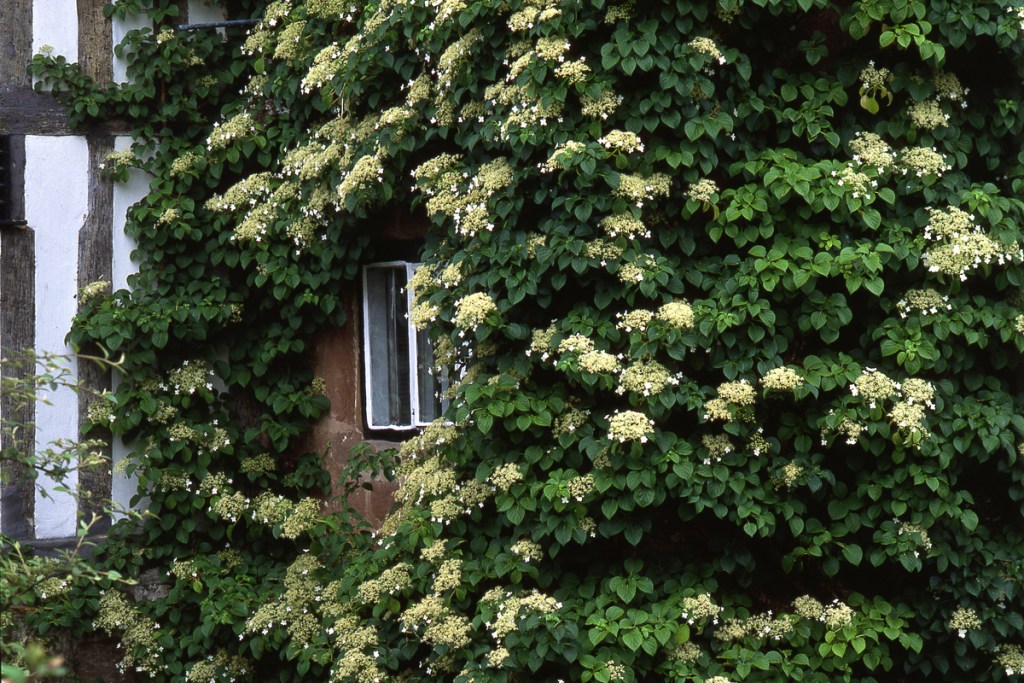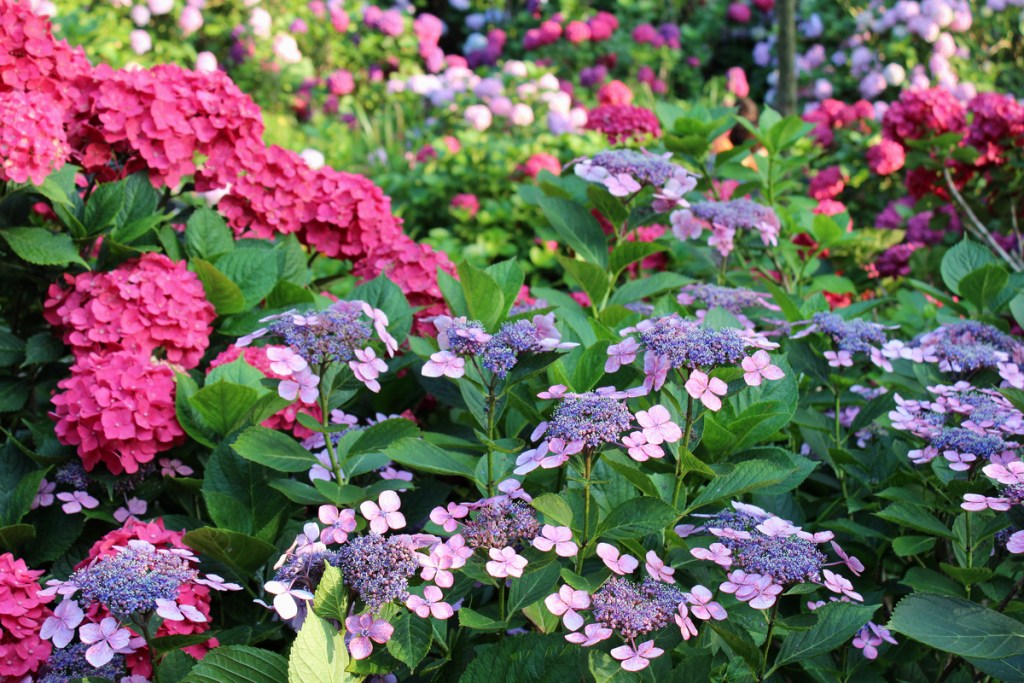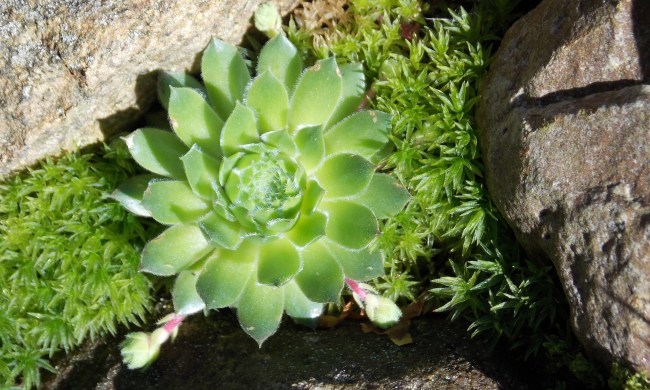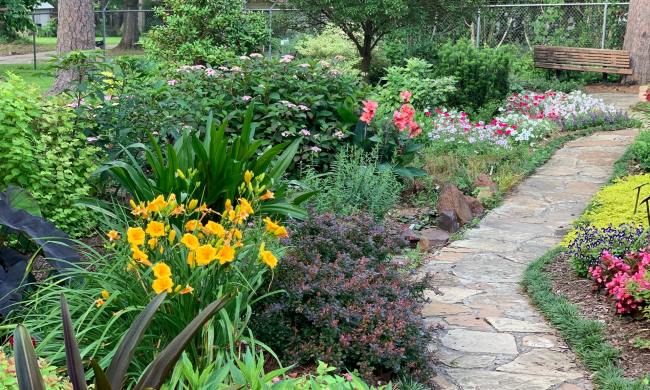Hydrangeas are some of the most popular flowering shrubs. Their big blooms brighten gardens, landscapes, and flower arrangements alike with shades of blue, pink, purple, white, or chartreuse. They have a timeless beauty that graces both traditional and contemporary designs, whether planted en masse, paired with other shrubs and perennials, or as an individual garden focal point. There are nearly limitless ways to include hydrangeas in the garden and many different types to choose from.
While there are dozens of hydrangea species throughout the world, mostly from Asia and the Americas, only six species are commonly found in American gardens. These plants share some traits, but each has its own unique growing and care requirements.

Hydrangea anomala ssp. petiolaris
Climbing hydrangea is native to moist, forested areas in Japan, the Korean peninsula, and far eastern China and Russia. It thrives in dappled sunlight in USDA hardiness zones 4 through 8. This plant features the unique habit of climbing by means of aerial roots that attach themselves to tree bark, stone, brick, or wood. Train it to a sturdy support structure, such as a wall, arbor, or fence, where it can grow up to 20 feet tall and 10 feet wide. The large, lacy, white flowers appear in May and June. Prune climbing hydrangea at the end of the early summer bloom period to maintain the overall size and a tidy appearance.
Hydrangea arborescens
Smooth hydrangea is a native plant of moist, forested slopes and ravines in the eastern United States. It is suitable for shade and partial sunlight gardens with average soil and moisture conditions in zones 3 through 9. The native plant blooms white, but several cultivars available through garden centers are pink. This species is a good choice for mass plantings in shady areas of shrub border plantings or as a background for perennials. Unlike many other popular hydrangeas, this one blooms on new wood and should be pruned in late winter or early spring. In late summer, simply deadhead and remove dead stems.

Hydrangea macrophylla, and Hydrangea serrata
Hydrangea macrophylla, or bigleaf hydrangea, is perhaps the best known of the genus. It originally came from Japan. This species includes the “mophead” and “lacecap” hydrangeas. Mophead types produce large, globe-shaped flower clusters. Lacecap hydrangeas make flattened clusters of large infertile flowers surrounding smaller fertile florets. It has a rounded growth habit, produces large pink or blue blooms in early summer, and grows best in zones 6 through 11.
The bloom color of most cultivars is linked to soil pH. Acid soils cause the blooms to be blue, while alkaline soils make them pink. Gardeners can manipulate the pH by adding aluminum sulfate to increase acidity, or lime to boost alkalinity. This species blooms on the prior year’s growth, or old wood, and so should be pruned after flowering. Bigleaf hydrangeas make beautiful mass plantings, foundation plantings, hedges, or container specimens.
Hydrangea serrata, known as mountain hydrangea, is easily confused with the H. macrophylla lacecap cultivars. However it is a smaller species overall, with smaller blooms well suited for container plantings or planted among perennials. It blooms in late summer on old wood, and should be pruned after blooming, if necessary. It is hardy in zones 6 through 9.
Hydrangea paniculata
Panicle hydrangea originally came from its wild habitat in China, Korea, Japan, and Russia. Unlike other hydrangeas, this is an excellent choice for gardeners with lots of sunshine. Also somewhat of a rarity among hydrangeas, panicle hydrangea produces white blooms on the current year’s new growth. Deadhead or prune to shape immediately after blooming to promote additional late season flowers. This large growing hydrangea tolerates full sun to partial shade, and is hardy in USDA zones 3 to 8. It makes an excellent tree-form specimen, mass planting, or hedge.

Hydrangea quercifolia
Oakleaf hydrangea is a woodland native of the southeastern United States. As with the previous species, this one grows well in full to partial sunlight. It blooms on old wood and should be pruned only after its early summer bloom cycle. In addition to the large, cone-shaped flower heads that mature from white to pink, this species produces outstanding red fall foliage color and attractive exfoliating bark on bare winter stems. Oakleaf hydrangea is hardy in zones 5 through 8. Use it as an informal hedge, foundation accent, or mass planting.
Plant and care for hydrangeas
Plant hydrangeas in well-amended soil to retain moisture while allowing excess water to drain. Feed them in the spring, when foliage emerges, with an organic or slow-release fertilizer formulated for acid-loving shrubs. Maintain a two- to three-inch layer of organic mulch around the root zone to keep the soil from drying out. Water during dry spells, but avoid wetting the foliage.
Hydrangeas offer beautiful, large flowers that look great even as they mature and dry on the plant. They can be used in a variety of ways to accent the landscape or even become a focal point on their own. With the proper plant selection and a bit of specialized care, you can enjoy a great looking hydrangea collection for decades.



